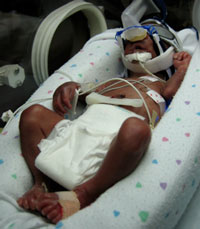As we know, the brain processes sensory inputs from the body in order to determine and initiate appropriate and coordinated motor output.
And as we know, premature and medically complex infants receive more than their share of sensory input during a critical period of brain development. This input is received by an amazing but immature system which is stressed by all it has to endure.
Sometimes his system simply begins to shut down – first state, then tone, and hopefully we don’t move on to autonomic instability. But that level of instability happens too, at times despite the best care possible.
I took this photo below over a decade ago (hopefully obvious). And much of the equipment and practices have improved greatly since.

But look at him as you walk up to the bedside. Note all the sensory input he’s receiving just from the equipment that supports and monitors his stability. And then the bedding, the bili mask, the leads…it’s overwhelming.
As a neonatal therapist, where do you come in?
1.) Innovate: Provide medical device companies with information and feedback in order to keep improving their products, interfaces and functionality. They want to know! And they need to know.
You (and of course NICU nurses and RTs) utilize equipment all day long. When you’re frustrated by the way something fits or interacts with your patients (and you’re sure you have the correct size etc) then literally take notes. Consider what would improve the product. Become an informed consumer of medical equipment/devices and contribute to its advancement whenever possible.
2) Educate:
Teach other staff about the importance of HOW they apply and remove that tape, secure the nasal prongs, position the baby for comfort and development and provide positive touch. And most importantly, teach parents how and why to support their baby during any type of care.
3) Provide Therapeutic Input:
Become very skilled at being the second pair of hands during 2-person care. In order to do this you must:
*Seek mentoring by an experienced therapist regarding how to do this safely and therapeutically. If you’re a newer neonatal therapist, begin with ‘older’ and more stable infants, and with experience and mentoring, move toward VLBW then ELBW infants.
* Learn how to be helpful to bedside nurses versus forging ahead with your own agenda. How do you know you’re being helpful? ASK them. I used to say things like, “Ok, show me what I can do to help you while not getting in your way.” I learned how to support the infant WHILE supporting the nurse. Everyone wins.
(For the record, nurses do more with 2 hands in that isolette than I can possibly imagine. But while they’re skillfully using those 2 hands the baby’s motor system is often unsupported and prone to stress. That’s where you come in. Support his motor and state systems, support self-regulation and observe how much better he tolerates care. When this is the infant’s experience over and over, the QUALITY of his sensory input improves. The CONSISTENCY of his sensory input and motor output improves.)
*Understand how to use this type of care to observe and gather important information about the baby’s tone, development, posture, movement patterns, symmetry, state transitions, self-regulation, and more. AND how to then support him in the moment. He’s building a system here.
You’re not in the role of ‘helper’ at the bedside. You’re a therapist. Use your unique lens to support the baby, the nurse or RT, and the family. Learn how to articulate what you’re doing.
Your observation skills, therapeutic input, and understanding of neurodevelopment bring a whole new view to the bedside and can positively affect the quality and consistency of sensory input and motor output this baby experiences.
Today. Tomorrow. For a lifetime.
